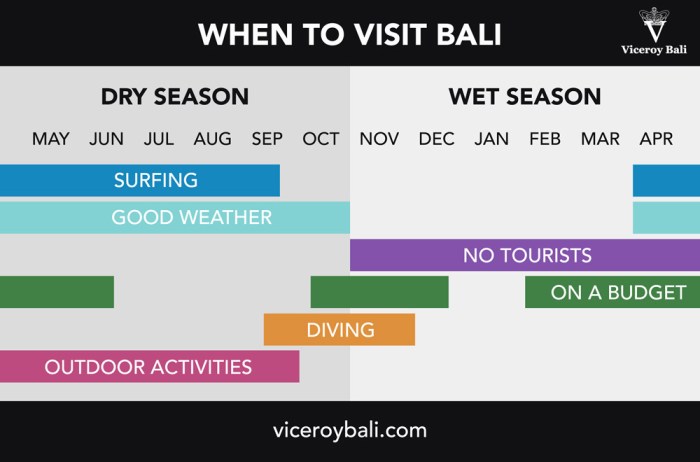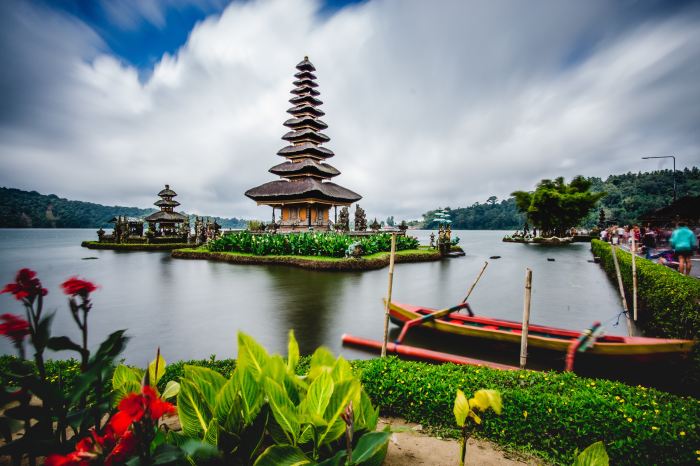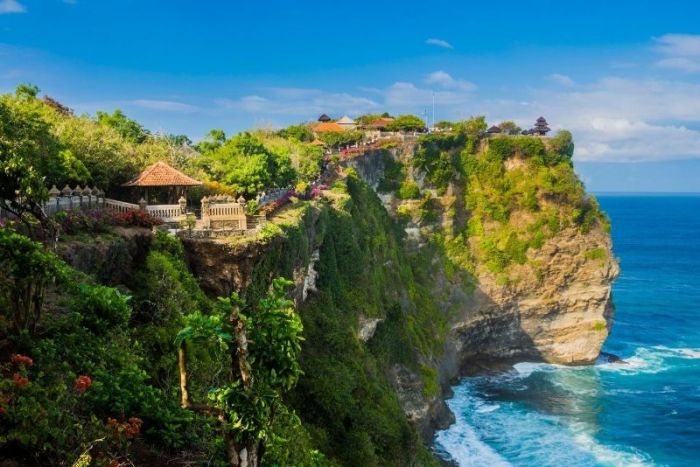Best time to travel to bali – When planning a trip to the enchanting island of Bali, selecting the best time to travel is crucial. Whether you seek sun-soaked beaches, vibrant cultural experiences, or serene spiritual retreats, this comprehensive guide will navigate you through the seasons, events, and weather patterns to ensure an unforgettable journey.
Bali’s tropical climate offers year-round warmth, but the timing of your visit can greatly impact your experience. From the bustling peak season to the tranquil off-season, each period presents unique advantages and considerations.
Peak Season
Peak season in Bali typically falls between June and September, coinciding with the dry season. This period offers several benefits for travelers, including:
- Sunny skies and minimal rainfall, making it ideal for outdoor activities like sunbathing, swimming, and exploring.
- Clear visibility for snorkeling, diving, and other water sports.
- Reduced humidity, leading to more comfortable temperatures.
However, peak season also has its drawbacks:
- Higher accommodation prices and limited availability, as demand for tourism increases.
- Crowded tourist attractions and beaches.
- Increased traffic and congestion, especially in popular areas.
During peak season, the average temperature in Bali ranges from 26°C to 30°C, with humidity levels between 60% and 80%. Rainfall is minimal, with an average of less than 100mm per month.
Shoulder Season

The shoulder season in Bali falls between the peak and low seasons, offering a balance of favorable weather, fewer crowds, and lower prices. It’s an ideal time to experience the island’s charms without the peak season’s intensity.
In Bali, the shoulder season typically runs from April to May and September to October. During these months, the weather transitions between the wet and dry seasons, resulting in a mix of sunshine and occasional showers.
Advantages of Shoulder Season
- Fewer Crowds:With fewer tourists visiting during the shoulder season, you’ll have the opportunity to explore Bali’s attractions with more space and tranquility.
- Lower Prices:Hotels, flights, and tours tend to be more affordable during the shoulder season, making it an excellent time for budget-conscious travelers.
- Pleasant Weather:While some rain can occur, the weather during the shoulder season is generally warm and sunny, with temperatures ranging from 25 to 30 degrees Celsius.
Disadvantages of Shoulder Season
- Unpredictable Weather:The shoulder season is known for its transitional weather, which means there’s a chance of rain, especially in the afternoons. It’s advisable to pack appropriate clothing and be prepared for occasional showers.
- Limited Availability:Some attractions and services may operate on reduced hours or have limited availability during the shoulder season. It’s essential to check in advance and make necessary arrangements.
Off-Season

Traveling to Bali during the off-season (April-May and September-October) offers both advantages and disadvantages. While the weather can be less predictable, with higher chances of rain, it also brings opportunities for significant savings and fewer crowds.
Weather Conditions
During the off-season, Bali experiences higher humidity and average temperatures between 25-30°C (77-86°F). Rainfall is more frequent, with an average of 10-15 rainy days per month. However, the rain is typically short-lived and doesn’t usually disrupt outdoor activities for extended periods.
Discounts and Deals
One of the main benefits of traveling during the off-season is the availability of discounts and deals. Hotels, resorts, and activity providers often offer reduced rates and promotions to attract visitors during this time. This can result in significant savings on accommodation, tours, and other expenses.
Specific Events and Festivals: Best Time To Travel To Bali
Bali’s vibrant culture and rich traditions are showcased through its numerous events and festivals throughout the year. These celebrations offer a unique opportunity to immerse oneself in the island’s spiritual, artistic, and social life.
Major Events and Festivals
- Nyepi (Balinese New Year): Celebrated in March or April, Nyepi is a day of silence and reflection. All activities, including travel and lighting, are prohibited, creating an atmosphere of tranquility and introspection.
- Galungan: A ten-day festival in May or June, Galungan marks the victory of good over evil. It features colorful parades, traditional music, and family gatherings.
- Kuningan: Held ten days after Galungan, Kuningan celebrates the return of ancestral spirits to the spiritual realm. It involves offerings, prayers, and communal feasts.
- Ubud Writers & Readers Festival: This literary event takes place in October or November, bringing together authors, readers, and literary enthusiasts from around the world.
- BaliSpirit Festival: Held in March or April, BaliSpirit Festival is a gathering for yoga, meditation, music, and conscious living. It offers a transformative experience for attendees.
Influence on Best Time to Travel
The timing of these events can influence the best time to travel to Bali for specific interests. For example, those interested in experiencing Nyepi’s unique silence and reflection may want to visit during March or April. For those seeking a vibrant cultural experience, Galungan and Kuningan in May or June offer an immersive opportunity.
If literature or spirituality is of interest, October or November is an ideal time for the Ubud Writers & Readers Festival or the BaliSpirit Festival.
Weather Considerations

Bali enjoys a tropical climate with two distinct seasons: the dry season (April-October) and the rainy season (November-March). The weather remains warm and humid throughout the year, with average temperatures ranging from 26°C (79°F) to 30°C (86°F).
During the dry season, rainfall is minimal, and the weather is mostly sunny and dry. This is the ideal time to visit Bali for outdoor activities such as swimming, surfing, and hiking. However, the dry season can also be crowded with tourists, especially during peak season (July-August).
The best time to travel to Bali is during the dry season, which runs from April to October. However, if you’re looking for a great place to travel in September, consider checking out best places to travel in september.
There are plenty of amazing destinations to choose from, whether you’re looking for a beach getaway, a cultural experience, or an adventure. And, of course, Bali is always a great option if you’re looking for a relaxing and rejuvenating vacation.
Rainy Season
The rainy season in Bali is characterized by heavy rainfall, especially during the months of January and February. While the rain can be unpredictable, it typically occurs in short, intense bursts. The rainy season can make outdoor activities more challenging, but it also brings lush greenery and vibrant landscapes.
Here is a table comparing the average temperature, rainfall, and humidity for each month in Bali:
| Month | Average Temperature (°C) | Average Rainfall (mm) | Average Humidity (%) |
|---|---|---|---|
| January | 28 | 330 | 85 |
| February | 28 | 300 | 85 |
| March | 28 | 200 | 80 |
| April | 27 | 150 | 75 |
| May | 27 | 100 | 70 |
| June | 26 | 50 | 65 |
| July | 26 | 50 | 65 |
| August | 26 | 50 | 65 |
| September | 27 | 100 | 70 |
| October | 27 | 150 | 75 |
| November | 28 | 200 | 80 |
| December | 28 | 300 | 85 |
Personal Preferences and Interests

Bali offers a diverse range of experiences, catering to various preferences and interests. The ideal time to visit the island depends on the activities and experiences you seek.
If you’re an avid surfer, the best time to visit is during the dry season (April-October) when waves are consistent and suitable for all skill levels. For those interested in hiking and trekking, the cooler months (May-September) provide optimal conditions with less humidity and rainfall.
Activities and Interests, Best time to travel to bali
- Surfing:April-October (dry season)
- Hiking and Trekking:May-September (cooler months)
- Cultural Immersion:Year-round (especially during festivals and ceremonies)
- Yoga and Meditation:Year-round (retreats and workshops available)
- Beaches and Sunbathing:Year-round (although some beaches may be more crowded during peak season)
Your budget and time constraints can also influence your decision. Peak season (June-August) offers the best weather and the most activities but can be more expensive and crowded. Shoulder season (April-May and September-October) provides a balance of good weather and lower prices.
If you’re looking for the best time to travel to Bali, consider September. It’s a great time to visit as the weather is pleasant and there are fewer crowds. If you’re flexible with your travel dates, you can also consider other destinations that are ideal for September travel, such as the Amalfi Coast or Tuscany.
For more inspiration, check out our guide to the best places to travel in September. No matter where you choose to go, you’re sure to have a memorable experience.
Off-season (November-March) is ideal for budget travelers and those seeking solitude, but be prepared for occasional rain.
Wrap-Up
Ultimately, the best time to visit Bali depends on your personal preferences and travel goals. Whether you crave lively crowds, cultural immersion, or secluded tranquility, Bali’s diverse seasons and offerings cater to every traveler’s desires. Embrace the island’s unique charm and create memories that will last a lifetime.
Expert Answers
When is the peak season in Bali?
The peak season in Bali runs from June to September, offering ideal weather conditions and a lively atmosphere.
What are the advantages of traveling during the shoulder season?
The shoulder seasons (April-May and October-November) provide a balance of good weather, fewer crowds, and lower prices.
Can I get good deals on accommodation during the off-season?
Yes, the off-season (November to March) often offers significant discounts on accommodation and activities.